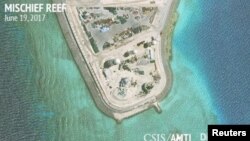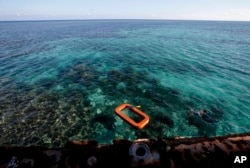ນັກຄົ້ນຄວ້າ ຈາກສະຖາບັນຂອງລັດຖະບານຈີນແຫ່ງນຶ່ງ ເວົ້າວ່າ ຈີນກໍາລັງໃຊ້ເທັກ
ໂນໂລຈີທີ່ກ້າວໜ້າ ເພື່ອຮັບໃຊ້ຜົນປະໂຫຍດພາຍໃນປະເທດ ຫລາຍກວ່າເພື່ອສົ່ງ
ເສີມການອ້າງເອົາອະທິປະໄຕຢູ່ໃນທະເລທີ່ມີການຂັດແຍ້ງກັນ.
ທ່ານ Lin Qi, ຜູ້ຊ່ວຍນັກຄົ້ນຄວ້າ ທີ່ສະຖາບັນສຶກສາ ກ່ຽວກັບທະເລຈີນໃຕ້ ແຫ່ງຊາດ
ຢູ່ແຂວງ Hainan ເວົ້າວ່າ ເຮືອດໍານໍ້າທະເລເລິກລໍານຶ່ງ ແລະເຄືອຂ່າຍສັງເກດການຢູ່
ໃຕ້ພື້ນນໍ້າ ທີ່ສ້າງຂຶ້ນໂດຍນັກວິທະຍາສາດຈີນ ຈະເກັບກໍາເອົາຂໍ້ມູນຢູ່ທະເລທີ່ເລິກທີ່
ສຸດຂອງໂລກ ເພື່ອວ່າອາດຈະໃຊ້ໃນການຂຸດຄົ້ນແຮ່ທາດ.
ທ່ານ Lin ທີ່ສະຖາບັນຂອງທ່ານ ຢູ່ໃຕ້ການປົກຄອງຂອງລັດຖະບານກາງນັ້ນ ໃຫ້ຄວາມ
ເຫັນເພີ້ມເຕີມວ່າ "ເຮົາສາມາດເວົ້າໄດ້ວ່າ ການເຮັດແນວນັ້ນແມ່ນຊ່ວຍປົກປ້ອງເຂດອໍາ
ນາດອະທິປະໄຕ ຂອງພວກເຮົາໄດ້ ສ່ວນໃດສ່ວນນຶ່ງ ແຕ່ວ່າ ທີ່ຈິງແລ້ວ ເປົ້າໝາຍຂອງ
ການສ້າງໂຄງການເຫຼົ່ານີ້ ຕົ້ນຕໍບໍ່ແມ່ນ ເພື່ອສະແດງໃຫ້ເຫັນເຖິງການອ້າງເອົາດິນແດນ
ດັ່ງກ່າວເລີຍ."
ທ່ານ Lin ກ່າວຢູ່ໃນການໃຫ້ສໍາພາດກັບວີໂອເອວ່າ ເທັກໂນໂລຈີນີ້ ຈະສໍາຫລວດເບິ່ງ
ບ່ອນເປັນຫລຸບໂນນ ແລະເປັນຄູຕ່າງໆ ຢູ່ພື້ນທະເລ ຊຶ່ງລວມທັງ ບ່ອນຫລຸບໂນນ ແລະ
ຄູຈໍານວນນຶ່ງຢູ່ທະເລຈີນໃຕ້ ແລະທະເລຈີນຕາເວັນອອກ. ຈີນກ່າວອ້າງເອົາຫລາຍກວ່າ
90 ເປີເຊັນຂອງເນື້ອທີ່ໃນເຂດທະເລຈີນໃຕ້ ຊຶ່ງໄປກວາມເອົາເຂດນ່ານນໍ້າ ທີ່ບຣູໄນ,
ມາເລເຊຍ, ຟີລິບປິນ, ໄຕ້ຫວັນ ແລະຫວຽດນາມຕ່າງກໍເອີ້ນວ່າ ເປັນຂອງຕົນນັ້ນ. ຍີ່ປຸ່ນ
ແລະຈີນ ໄດ້ຜິດຖຽງກັນໃນການຍາດເອົາບາງສ່ວນ ຂອງເຂດທະເລຈີນຕາເວັນອອກ.
ຢ່າງໃດກໍຕາມ ພວກນັກຄົ້ນຄວ້າຈາກສະຖາບັນຂອງລັດຖະບານ ມັກຈະໃຫ້ ຄວາມເຫັນ
ທີ່ສະທ້ອນເຖິງທັດສະນະຂອງລັດຖະບານຈີນ.
China is using technological advances to explore contested seas for domestic reasons rather than to bolster maritime sovereignty claims, a scholar from a state-run Chinese academy said.
A deep-sea bathyscaphe and an underwater observation network developed by Chinese scientists will gather data on the world's deepest seas for possible use in tapping minerals, said Lin Qi, assistant researcher with the National Institute for South China Sea Studies in Hainan province.
"You could say to some extent that helps protect our sovereignty claim, but actually the goal of these projects' designs is not mainly one to show the country's claim," said Lin, whose institute falls under the central government's purview.
What China is chasing with new technology
That technology will probe undersea mounts and trenches including some in the East and South China Sea, Lin told VOA in an interview. China claims more than 90 percent of the South China Sea, overlapping waters that Brunei, Malaysia, the Philippines, Taiwan and Vietnam call theirs. Japan and China dispute parts of the East China Sea.
Scholars from state-run institutions often reflect the views of the Chinese government.
Observers outside China see the Jiaolong deep-sea exploring bathyscaphe and the planned underwater observation network as gambits to tighten the country's control over the 3.5 million-square-kilometer South China Sea.
The Jiaolong, an undersea observation vehicle, just completed five years of tests in preparation for a global mission in 2020, Chinese state-controlled media reports said in June. The observation network would transmit back to land "real time" seabed information and explore its chemistry, physics and biology "for the comprehensive needs of multiple applications," the government's China Oceanic Information Network said earlier this year.
Why China will plumb the depths of disputed seas
China's deep-sea technology led to attention internationally because of the plans to deploy it in contested waters, Lin said.
Deployment there makes sense because the Yellow Sea and Bohai Gulf near China are relatively shallow, not requiring much of a probe, Lin said.
China especially hopes to take photos from the farther-reaching, deeper oceans, he said. Research eventually will be "very helpful" for finding minerals, he added, though he sees little relation to undersea oil exploration. Oil and gas typically come from under continental shelves and continental slopes rather than deeper ocean floors.
Chinese officials want to find new resources for their 1.37 billion people and a manufacturing-reliant economy that's forecast to grow 6.7 percent this year, analysts say. For example, they need sources of cleaner-burning fuel to offset the air pollution from coal burning.
Lin rejected fears abroad that data would be used to strengthen the military. The armed forces operate largely in secrecy and has been gaining a foothold on some of the larger South China Sea islets.
"Because people's level of knowledge is insufficient, you can say that in terms of the deep sea field a lot of countries have painstakingly done this kind of research, and the Jiaolong is China's representative program," Lin said.
Multiple purposes for deep-sea exploration
Experts outside China believe Beijing is using technology to pursue resources as well as chances to prove sovereignty.
"Number one, there is an economic aim to it and number two, it is an act of exhibiting sovereignty," said Oh Ei Sun, international studies instructor at Singapore Nanyang University.
China has upset rival Southeast Asian claimants over the past decade by creating artificial islands for military use and passing coast guard vessels through the exclusive economic zones of other governments.
China's search for resources could ruffle other countries, too, he said. Prospecting for undersea oil touched off a boat-ramming incident in 2014. Beijing's discovery of the "combustible ice" natural gas hydrate in the South China Sea could spark a race for the resource with the less technologically advanced Southeast Asian claimants, some experts say.
The Chinese Academy of Sciences quoted a government official in May calling that discovery a "major breakthrough that may lead to a global energy revolution."
China's deep sea work helps it show off to the world, as well as inspire its citizens to believe in the Communist Party's leadership, said Fabrizio Bozzato, a Taiwan Strategy Research Association fellow specialized in Asian political issues.
"Beijing is trying to kill several birds with one stone," Bozzato said. "It is trying to enhance its soft power and national prestige but also is further marking the territory in that maritime domain."





